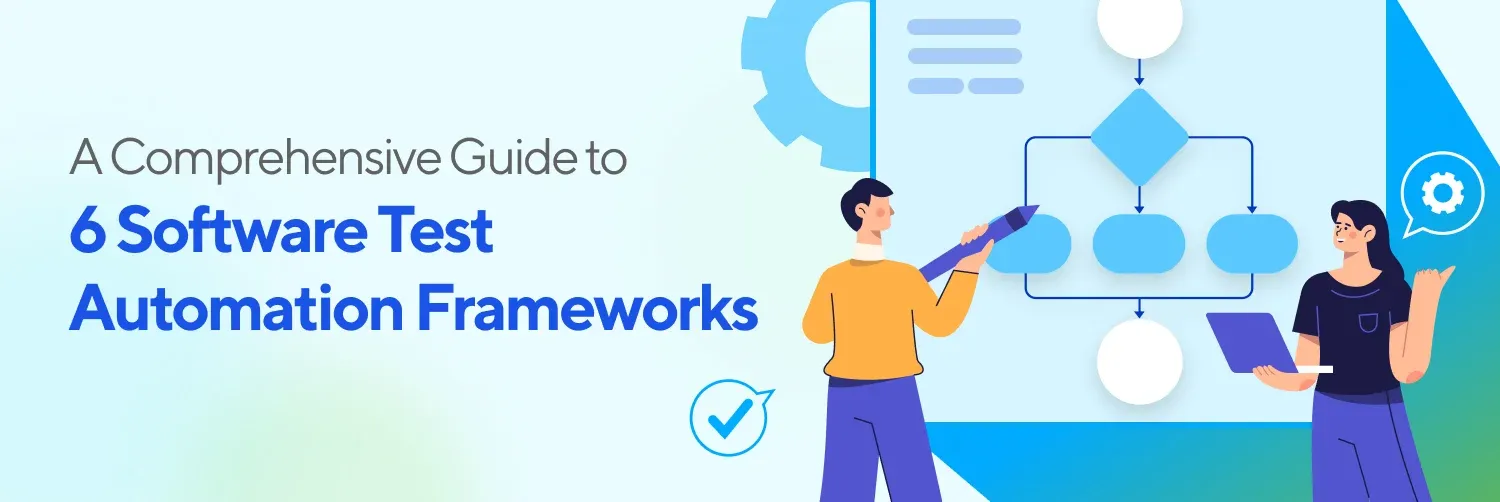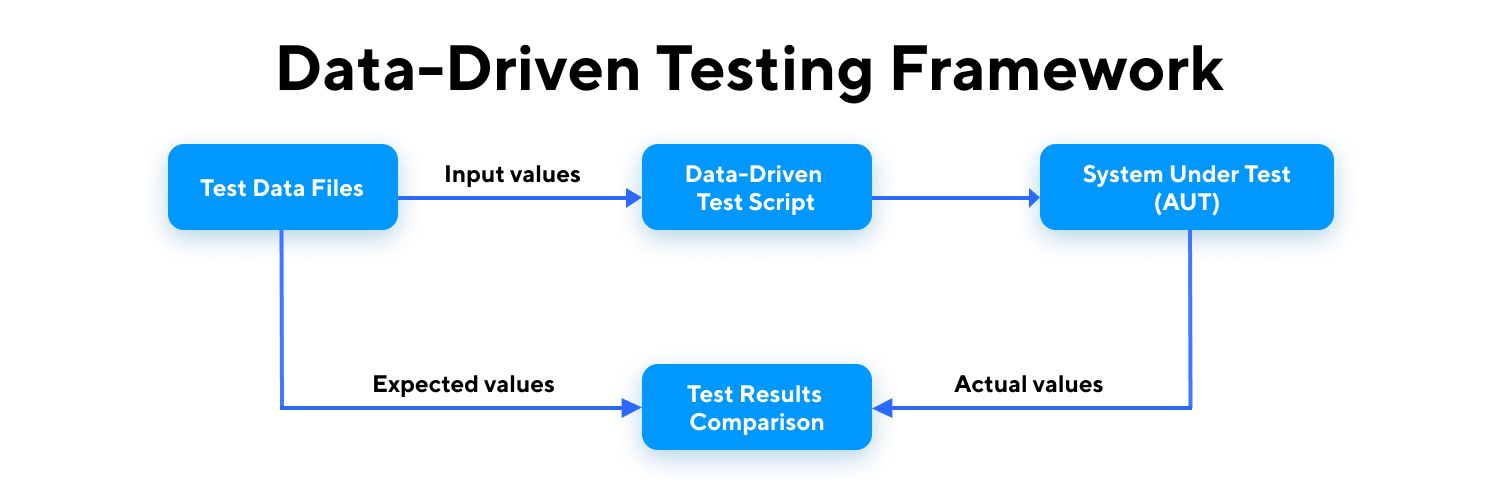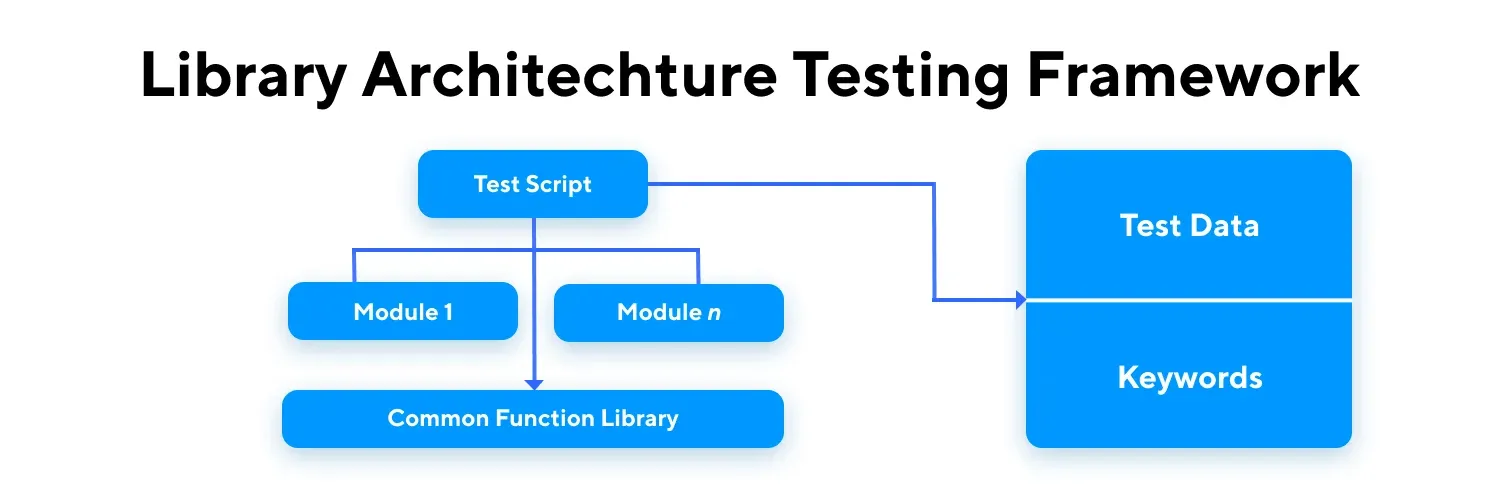
Software Test Automation Frameworks | 6 Common Types

Software testing has evolved with time to detect and lessen errors in software and applications. The key software testing trends in 2022 suggest that 63% of QA teams consider test automation over manual testing for the agility required during the software development lifecycle (SDLC) while being cost-efficient.
Manual testing still holds a fair share in testing processes, but enterprises have also heavily relied on automated testing to get over tedious, repetitive, and time-consuming tasks. Test automation has been vigorously in practice to ensure applications behave as expected, and test automation frameworks are an integral part of the entire process.
Below we will expand more on what is a test automation framework, why organizations need it, and what advantages it has over platforms and tools.
What is a Test Automation Framework?
A test automation framework provides QA professionals with different blends of libraries, guidelines, coding standards and methods to create testing tools or platforms. After a test automation IDE has been created, the creator can customize different feature sets for creating, executing, and maintaining future test cases.
The components that make up a test automation framework include test data, driver scripts, environment variables, general user library, business user library, recovery scenarios, object repository, AUT(Application-Under-Test), and test execution report.
5 Reasons Why You Need Test Automation Framework
Here are a few reasons why you should start using frameworks for test automation.
- Organization: store test scripts/artifacts in a single location.
- Maintenance: Automation frameworks facilitate seamless test maintenance. Keeping your tests up to date with code changes is easy and fast, with structured artifacts available.
- Reusability: An automation framework vastly increases reusability by creating test scripts useful across several software functions.
- Scalability: The ever-changing scenarios and requirements need some of the tests to be scaled up and down. A test automation framework minimizes the development effort for scaling the testing capabilities for a wide variety of tests, including, but not limited to, load testing, functional testing, and unit testing.
Given that test automation frameworks also contribute to better test accuracy, it's common to find them as a crucial component of modern DevOps practices. There are several paid and open-source testing tools enterprises leverage to execute tests on applications.
Types of Test Automation Framework
Linear Test Automation Framework

A linear or record-and-playback test automation framework is mostly used for projects that have basic testing needs. Test cases and scripts are created by testers’ interactions on the system-under-test; clicking a “Login” button or inputting usernames and passwords.
However, though the linear test automation framework offers a much faster and low-code approach to design tests, the maintenance effort is also high. Record-and-playback tests break easily. Even the slightest changes in the application or UI code can result in nonreusable tests.
That’s why record-and-play tests are mostly used in:
- Learning automated testing: Helping learning testers to explore test methods, underlying test code, and object repositories and use them as references for more advanced scripting in the future
- Applications with simple functionalities: A straightforward page that doesn’t have new features introduced constantly will be the perfect fit for the linear test automation framework
Modular-Based Testing Framework

The name gives it away as the modular-based test frameworks require testers to divide larger test scripts into smaller and manageable units, sections, or functions. Each small module is independently tested with both an incremental and non-incremental approach. These modules are the test cases broken down by the testing framework.
In addition, QA professionals can also store a script in the function library after they are done writing it. It allows them to easily make changes to a certain script rather than accidentally touching other areas, thus reducing risks in testing. Unfortunately, this also asks for good knowledge of the application/software code to find reusable test artifacts and flows.
Data-Driven Testing Framework

Excel/CSV, GraphQL, Oracle SQL or databases with JDBC drivers are common datasets used for data-driven testing.
It's quite frequent for testers to run multiple tests on similar features or functions of an application with different test data. Using a data-driven framework allows testers to separate script logic from the test data, preventing them from coding the test data every time into the script itself.
While the linear and modular-based testing framework allows changes to the individual scripts, the data-driven test framework allows testers to store and pass data from external sources such as excel sheets, CSV files, text files, ODBC repositories, or SQL tables to test scripts.
The test scripts then read the necessary input/output parameters from these data sources and quickly execute tests across different scenarios.
Keyword-Driven Testing Framework

The keyword-driven framework lays out a series of predefined actions and methods through keywords. Keywords are a favorite among teams with mixed coding expertise. For example, if a QA team consists of 1 developer and 3 manual testers, the designated developer would be in charge of building those keywords for the manual QAs to write tests.
Keywords in the scripts represent different actions performed for testing an application's GUI. These keywords are sometimes labeled in simple terms such as: "login", or 'click', whereas sometimes they are complex such as 'verifying' or 'clicklink'.
In this approach, keywords must be stored with the associated object or the UI that requires an action to be performed. For a keyword-driven testing framework to work, objects are mapped to their required actions with the help of a shared object repository. Note that the developed keywords can be used across multiple test scripts.
Library Architecture Testing Framework

The library architecture test framework follows similar guidelines as the modular framework but with some additional benefits for the testers. Rather than dividing an application into various scripts to run, the framework identifies, groups, and stores similar tasks within scripts in a common library.
This common library serves the purpose of calling necessary functions when creating test scripts.
Similar to the modular test automation framework, test maintenance and scalability are easier and cost-efficient. However, since you still need to hard code test data into the script, any changes to the data will eventually result in changing the scripts.
Hybrid Test Automation Framework

A hybrid test automation framework combines all other test framework types to provide QA teams with a time and cost-efficient testing approach. It mitigates the limitations of each test framework and blends their advantages to improve testing efficiency. As the need for test automation rises, hybrid frameworks successfully address all the issues defined by testers during the testing process.
Katalon - The Hybrid Test Automation Framework
Enterprises find it hard to boost their testing teams' speed without compromising product quality.
Built on the hybrid test automation framework, Katalon offers testing professionals the complete set of testing solutions to test software and applications.
With the purpose of removing the need to build frameworks and reinvent the wheel using open-source libraries, Katalon brings the community:
- Page-Object Model Design: reuse and recycle all created test objects, profiles and cases
- Record-and-Playback Testing: capture, view object properties and generate tests based on every action taken on the System Under Test
- Keyword-Driven Testing: jam-packed library of built-in keywords to 2x the speed of designing test steps and actions
- Data-Driven Testing: test against a combination of CSV/Excel files, internal databases and external databases ( Oracle SQL, SQL Server or databases with JDBC drivers)





